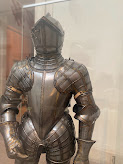Journey through the Metropolitan Museum's medieval wing with an insightful look at a unique 11th-century ivory carving of Christ 'The Door' and a plaque featuring the Four Evangelists, unveiling the rich tapestry of Byzantine, Islamic, and Norman art influences.
Christ the Door
I find myself in the medieval wing of the Metropolitan Museum of Art, standing before an exquisite ivory carving of Christ. This piece, likely intended as a book plate for an illuminated manuscript, originates from the 11th century CE. During this period, particularly in Southern Italy, there was a flourishing of art influenced by a confluence of diverse cultures — Byzantine, Islamic, and Norman, to name a few.The Metropolitan Museum of Art has interesting artifacts—like this ivory object depicting Christ surrounded by symbols of the four Evangelists.
Such ivory works were integral to the trade networks linking the Islamic world and other regions across the Arab world, serving as a testament to the cultural intersections at the Mediterranean crossroads. This is evident in the variety of objects within this display case, all crafted from ivory, symbolizing this rich cultural exchange.
Interestingly, this particular depiction of Christ is unique. He is shown holding the gospel book, referencing a passage from the Gospel of John, Chapter 10: ‘I Am the Door.’ It’s a fascinating symbolic choice, as Christ is not commonly portrayed as a door, despite the theological significance of the metaphor — representing the doorway to salvation. This element adds a distinctive layer to this already remarkable artifact.
The Four Evangelists
In the same display of ivory works, I stumbled upon another mesmerizing piece of history - an ivory plaque dating back to around 1050 CE. By the way — in the following video, I apologize for the audio quality; the museum is busy today!

 .
. 




